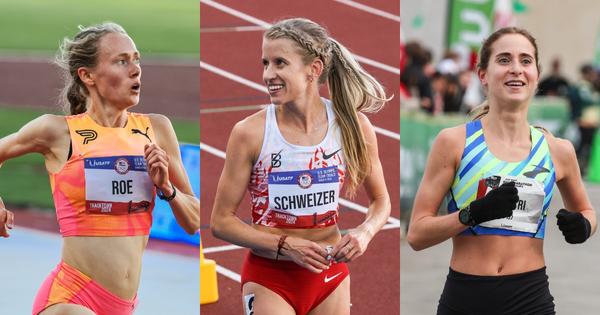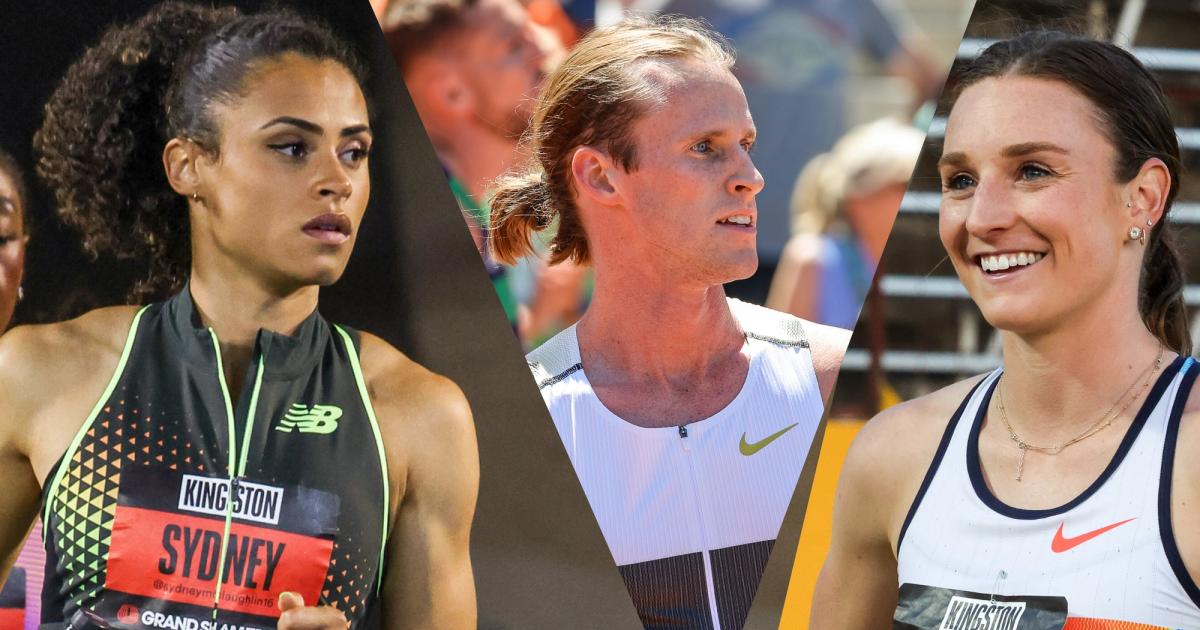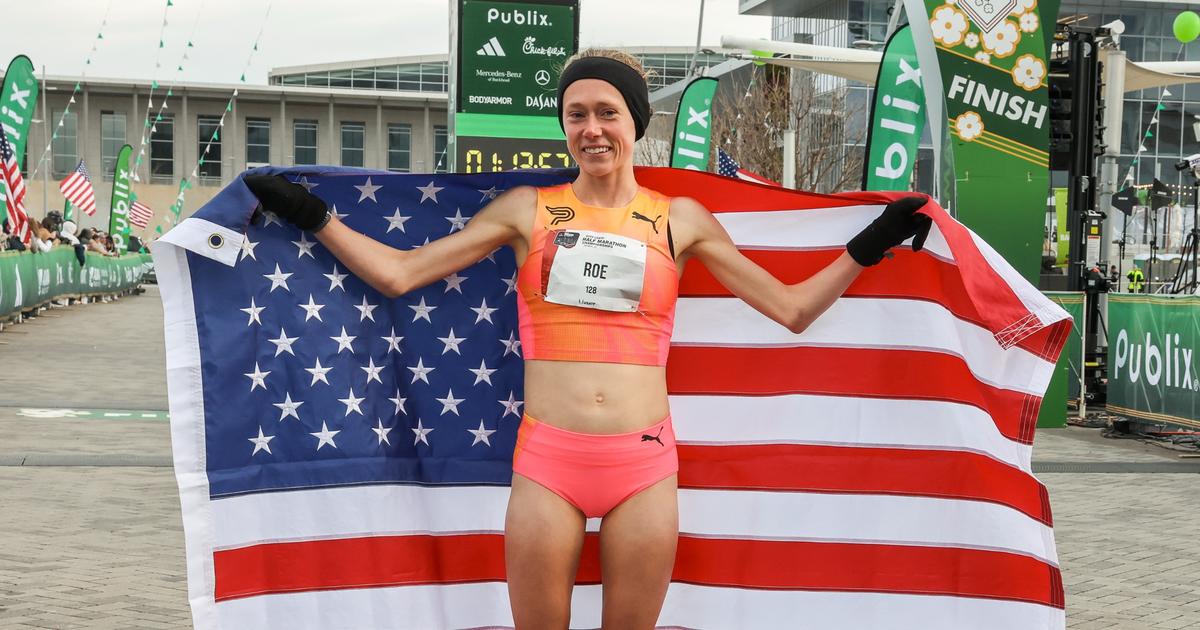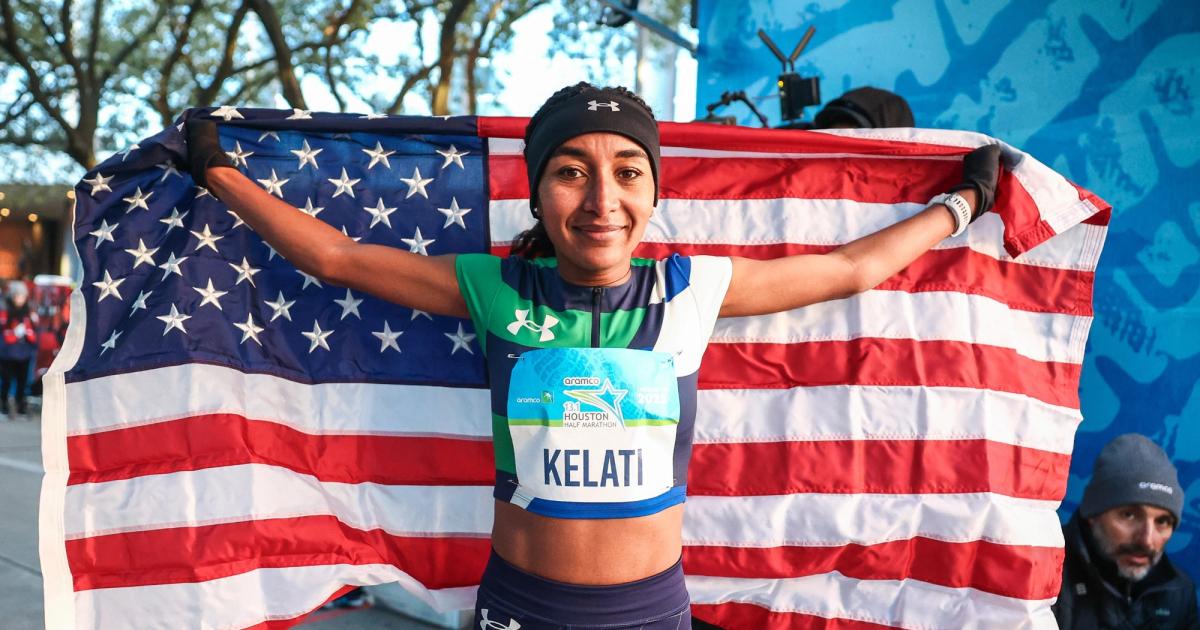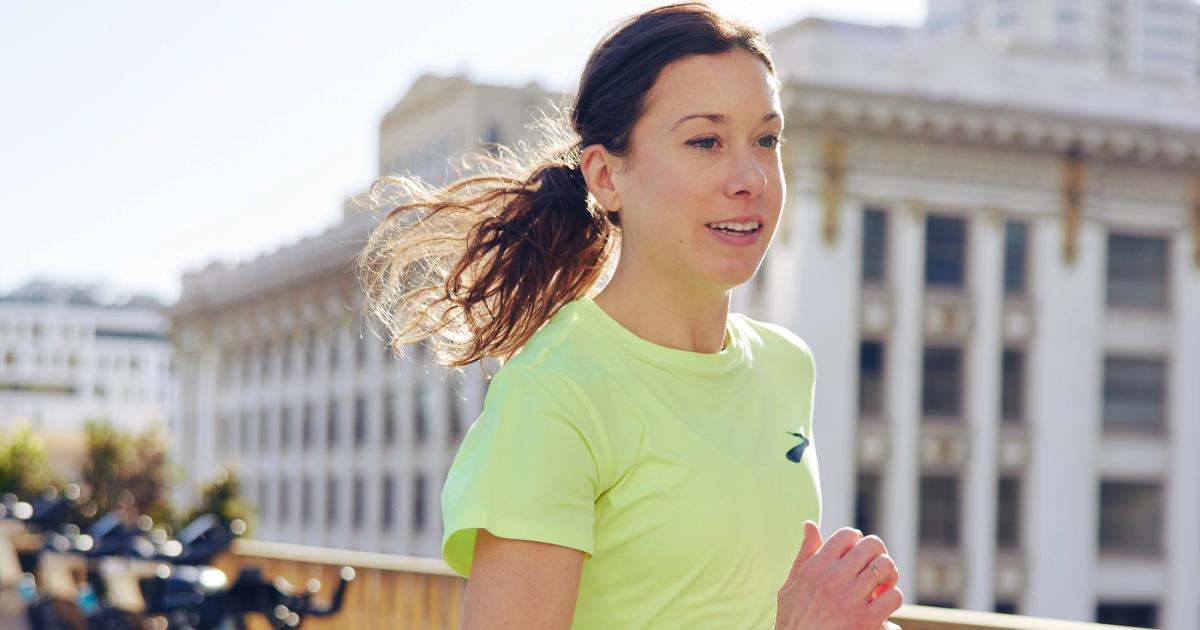By Chris Chavez
July 23, 2025
The memes about my 10,000m World Rankings obsession have already started. With about a week to go until the start of the U.S. Outdoor Track and Field Championships, I figured it would be a good time to revisit what this year’s qualifying outlook is like for some of the top American women.
World Athletics remains steadfast in its goal of filling fields 50% via qualifying standard and 50% via World Rankings, so they dropped the women’s 10,000m qualifying standard from last year’s Olympics from 30:40.00 to 30:20.00 for this year’s Worlds. (By contrast, on the men’s side, 21 of the 27 spots right now are occupied by men who have run under the 27:00.00 qualifying standard.)
The target field size for the World Championships in Tokyo is 27 competitors, which is the same as last year’s Olympics.
– Seven spots are already spoken for, since Kenya is sending three women who have the World Championships standard, and Ethiopia will actually be able to send four women—three with the standard, plus Gudaf Tsegay, who as reigning World champion has a bye. (Tsegay has yet to state whether she will triple or double with the 1500m/5000m/10,000m as her options).
– Three athletes—Daisy Jepkemei, Nadia Battocletti, and Francine Niyomukunzi—have spots from cross country. (More on Jepkemei and Battocletti later.)
– Brazil’s Nubia De Oliveira Silva is provisionally qualified as the South American champion.
That leaves 16 spots available via the World Rankings quota for athletes to get on the starting line in Tokyo.
In the same way that I laid this out for fans last year, let’s dive into it again:
Which Americans have the standard?
None. No American woman has run under the 30:20.00 World Championship standard within the current qualifying window. Alicia Monson (30:03.82 in 2023), Molly Huddle (30:13.17 in 2016), Elise Cranny (30:14.66 in 2022), and Karissa Schweizer (30:18.05 in 2022) are the only American women to have run under that time ever.
Is anyone else qualified?
Yes. There are three American women currently in the World Rankings quota: Weini Kelati (11th in the quota), Karissa Schweizer (14th in the quota), and Parker Valby (17th in the quota).
That said, last week, there were two more. Jess McClain (who has already been selected to race the marathon in Tokyo) and Taylor Roe (who won the U.S. Half Marathon Championships and was set to race the World Road Running Championships before they were canceled) were in the World Rankings quota, but have since seen their World Rankings drop them out.
Huh? What does that even mean? How did that happen?
The thing with targeting a quota spot is that it tends to be a moving target. Up until Wednesday, it looked like a 1212 average Ranking Score would be enough to get you into the quota but now it’s starting at 1218.
Though unlikely, athletes could run a fast 10,000m at their various national championships over the next two weeks that could shake things up further. For instance…
The Kenyan trials for the World Championships in Tokyo took place on Tuesday. Behind the newly anointed Kenyan 10,000m Worlds squad of Janeth Chepngetich, Agnes Ngetich, and Beatrice Chebet, Uganda’s Joy Cheptoyek finished fourth in a personal best of 30:41.95. With that time, she just missed the standard, but earned a 1209 World Rankings performance score. (World Athletics doesn’t fuss with altitude conversions like the NCAA does, which is notable, because that time was run at nearly 6,000 feet.) Cheptoyek ran 30:22 (1227 World Rankings performance score) on the roads in Tokyo back in May. Now, this performance moved her into the World Rankings quota with an average 1218 Ranking Score.
How do athlete scratches—like Parker Valby—impact things?
Funny enough, last year we had a whole article dedicated to Valby’s qualifying chances and she had an entire section in our 10,000m overview. This year is a different story. Valby, last year’s 11th-place finisher in the Olympic final, shared on Instagram that she will not be racing at the U.S. Championships as she continues to work her way back from a foot injury that has sidelined her for her first professional outdoor season.
So if we remove Valby from the World Rankings quota since we know she will not be contesting the national championship, Japan’s Rino Goshima will move into the World Rankings quota. Now, Goshima has only raced once in 2025 and it was a 2:26:08 personal best for 10th place at the Nagoya Women’s Marathon in March. She has not raced a 10K or 10,000m since her 18th-place finish at the Paris Olympics.
However, will she pass up the opportunity to race at a home World Championships? I asked Brett Larner of Japan Running News, if he knew anything about Goshima’s decision, and he hadn’t heard much news since her marathon performance. He noted that unless she was injured, she could take the spot since this national team is worth a ton to the corporate teams.
CITIUS MAG reached out to Goshima's agent for any clarity and they responded saying: "Rino's plans are still uncertain, even if a quota spot becomes available for her. I believe Rino and her coach will make a decision once they receive that news."
So what’s the best scenario for athletes like McClain and Roe?
They have to hope more runners ahead of them in the 10,000m World Rankings opt to contest a different event! And that no all-star talent decides they want to enter the fray.
Let’s call this the 10K World Rankings Watch List. Here’s who we will be monitoring:
– Great Britain’s Calli Hauger-Thackery is currently No. 18 in the quota for the 10,000m. However, back in May, British Athletics named her to the World Championships marathon team. The 10,000m-marathon double is not possible in Tokyo.
Her husband and coach Nick Hauger told CITIUS MAG that she is still undecided at the moment. The two will continue in their training block over the next two weeks before making a decision.
– Kazakhstan’s Daisy Jepkemei has one of the cross country spots. She did just run 30:48.44 back in May. However, she is also steepling this season and is in the World Rankings quota for the steeplechase, too. Could she do the 10,000m/steeplechase double? She just did that at the 2025 Asian Games (however, it was one round of the steeplechase first and then the 10,000m) and came away with a gold medal in the 10,000m and a bronze medal in the steeplechase. In Tokyo, the 10,000m is on Day 1 and the heats of the steeplechase are on the morning of Day 3.
– Olympic silver medalist Nadia Battocletti scratched from the London Diamond League, but unless it’s a major injury—and she hasn’t said anything publicly suggesting it is—I’d expect her to be at Worlds.
– 10,000m Olympic bronze medalist Sifan Hassan is currently preparing to run the Sydney Marathon in August. She has not raced on the track since last summer but if she gets the itch to run a 10,000m in the next few weeks, she has the talent to run the standard or factor into the World Rankings quota.
So what do U.S. athletes need to do at USAs to actually qualify for Worlds?
If you are Weini Kelati and Karissa Schweizer: You simply need to finish top three in the race. These two are not in any danger of being pushed out of the quota by other results. It’s in their interest for the race to be won in a slow time, so that other U.S. athletes can’t get into the quota.
Winning times at the U.S. Championships over the years:
2021 – 31:03.82 by Emily Sisson
2022 – 30:49.56 by Karissa Schweizer (held at the Prefontaine Classic in May)
2023 – 32:12.30 by Elise Cranny
2024 – 31:41.07 by Weini Kelati
If you are Jess McClain and Taylor Roe: You are very close to being in the quota, and potentially a couple of scratches could get you back in, in which case a top-three finish should do the job.
However, to improve to 1218 points for more certainty, Jess McClain needs another 1218 point performance, which would require finishing quicker than 31:23.21 for a third place finish (1173 points plus 45 placing points) or faster than 31:40.40 while winning (1158 points plus 60 placing points).
Taylor Roe’s 30:58.66 performance at the TEN was worth 1234 points (1194 points plus 40 placing points), meaning she needs a further 1202 points to improve to an average of 1218. This would require a time of 31:41.55 along with a third place finish (1157 points plus 45 placing points) or 31:58.85 in victory (1142 points plus 60 placing points).
McClain could also complicate other people’s qualifying hopes if she finishes in the top three, gets into the World Rankings quota and decides to pass on her spot on the 10,000m team to focus on the marathon. Fourth place could be doing math to see if they ran fast enough and whether their 40-point fourth place bonus is enough to help get them into the quota.
If you are Elise Cranny and Emily Infeld: You have run only one 10,000m race in the qualifying window. USAs will provide the necessary second performance to enable them to make their way into the quota.
For Cranny, her previous performance was at the TEN, where she won in 30:36.56 for a spectacular 1274 points (1214 points plus 60 placing points for the win). To guarantee 1218 points for a spot in the quota, Cranny would only need a second score of 1162 points and to run quicker than 32:27.90 (1117 points plus 45 placing points) at USAs with a third place finish, or faster than 32:45.45 (1102 points plus 60 placing points) with the win.
Infeld’s performance at the Ten was 30.59.38 for fourth and worth 1223 points once you include her 30 placing points for that place. Up until this week, Infeld wasn’t in the quota but her 11th place finish in 31:56 at the NYRR Mini 10K on a hot, humid day in New York City registers as her No. 2 performance with a 1134 performance score. She’ll likely run better at USAs. She would need a 1213 point showing, which would involve running 31:28.93 for third place or 31:46.16 with a win.
If you are Grace Hartman or Amanda Vestri: You have two 10,000m or 10K performances on your record but need a World Rankings quota boost, as well as achieve a top three finish to guarantee a spot in Tokyo.
Hartman’s 1214 point performance for second place at NCAAs means she needs 1222 points at USAs. That could come in the form of a 31:18.64, third-place finish or a 31:35.81 win.
Vestri’s excellent showing at the Night of 10,000m PB’s in London back in May 2024 gives her 1228 points, so her second score would need to be a more modest 1208 points, which equates to 31.34.66 and a third place finish or 31:51.92 and a win
Will we know for certain if the top three in Eugene are on the team?
The short, unsatisfying answer is that it depends on who the top three finishers are and potentially how quickly they run. Last year, part of the reason why the trials race was as fast as it was is due in part to Valby pushing the pace from the front.
A likely outcome is that Kelati, Schweizer, and Cranny finish top three and make the team. Kelati and Schweizer are the top returners from 2024, and while Cranny ran the 1500m/5000m double at last year’s Trials, she’s the 2023 national champion in this event. 32:27 should be well within her ability, even in a kicker’s race, and she’s the fastest American in the event by season’s best. But anything can happen on race day, and if one or more of that trio finish in the top three, we’ll have to do some serious math.
If any non-Kelati-or-Schweizer athlete places in the top three but does not run fast enough to make it into the quota, they’ll have the opportunity to chase a quota spot after USAs by posting another, faster time.
But, this would require finding a World Athletics-certified 10,000m or 10K road race, and also the time that would be required would be significantly faster, as there likely wouldn’t be any sort of placing points available in such a race.
Note: I majored in journalism and have a minor in Spanish so if my math is off in any of this, please feel free to email me to make any corrections at chris@citiusmag.com

Chris Chavez
Chris Chavez launched CITIUS MAG in 2016 as a passion project while working full-time for Sports Illustrated. He covered the 2016 Olympics in Rio de Janeiro and grew his humble blog into a multi-pronged media company. He completed all six World Marathon Majors and on Feb. 15th, 2025 finally broke five minutes for the mile.
